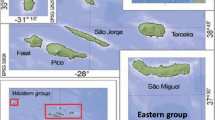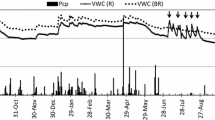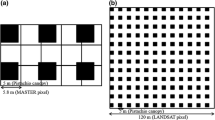Abstract
Accurate parameterization of reference evapotranspiration (ET0) is necessary for optimizing irrigation scheduling and avoiding costs associated with over-irrigation (water expense, loss of water productivity, energy costs, and pollution) or with under-irrigation (crop stress and suboptimal yields or quality). ET0 is often estimated using the FAO-56 method with meteorological data gathered over a reference surface, usually short grass. However, the density of suitable ET0 stations is often low relative to the microclimatic variability of many arid and semi-arid regions, leading to a potentially inaccurate ET0 for irrigation scheduling. In this study, we investigated multiple ET0 products from six meteorological stations, a satellite ET0 product, and integration (merger) of two stations’ data in Southern California, USA. We evaluated ET0 against lysimetric ET observations from two lysimeter systems (weighing and volumetric) and two crops (wine grapes and Jerusalem artichoke) by calculating crop ET (ETc) using crop coefficients for the lysimetric crops with the different ET0. ETc calculated with ET0 products that incorporated field-specific wind speed had closer agreement with lysimetric ET, with RMSE reduced by 36 and 45% for grape and Jerusalem artichoke, respectively, with on-field anemometer data compared to wind data from the nearest station. The results indicate the potential importance of on-site meteorological sensors for ET0 parameterization; particularly where microclimates are highly variable and/or irrigation water is expensive or scarce.






Similar content being viewed by others
Notes
Mention of trade names or commercial products in this publication is solely for the purpose of providing specific information and does not imply recommendation or endorsement by the U.S. Department of Agriculture.
References
Allen RG, Pereira LS, Raes D, Smith M (1998) Crop evapotranspiration: guidelines for computing crop water requirements. Food and Agriculture Organization of the United Nations, Rome
Allen RG, Walter IA, Elliott RL et al (2005) The ASCE standardized reference evapotranspiration equation. American Society of Civil Engineers, Reston
Andales AA, Bauder TA, Arabi M (2014) A mobile irrigation water management system using a collaborative GIS and weather station networks. In: Practical applications of agricultural system models to optimize the use of limited water. American Society of Agronomy, Inc., Crop Science Society of America, Inc., and Soil Science Society of America, Inc., Madison, pp 53–84
Anderson RG, Wang D, Tirado-Corbalá R et al (2015) Divergence of actual and reference evapotranspiration observations for irrigated sugarcane with windy tropical conditions. Hydrol Earth Syst Sci 19:583–599. doi:10.5194/hess-19-583-2015
Ayars JE, Fulton A, Taylor B (2015) Subsurface drip irrigation in California—here to stay? Agric Water Manag 157:39–47. doi:10.1016/j.agwat.2015.01.001
Bartlett AC, Andales AA, Arabi M, Bauder TA (2015) A smartphone app to extend use of a cloud-based irrigation scheduling tool. Comput Electron Agric 111:127–130. doi:10.1016/j.compag.2014.12.021
Bitella G, Rossi R, Bochicchio R et al (2014) A novel low-cost open-hardware platform for monitoring soil water content and multiple soil–air-vegetation parameters. Sensors 14:19639–19659. doi:10.3390/s141019639
Carrow RN (2006) Can we maintain turf to customers’ satisfaction with less water? Agric Water Manag 80:117–131. doi:10.1016/j.agwat.2005.07.008
Chaves MM, Santos TP, Souza CR et al (2007) Deficit irrigation in grapevine improves water-use efficiency while controlling vigour and production quality. Ann Appl Biol 150:237–252. doi:10.1111/j.1744-7348.2006.00123.x
Chiang C-T (2015) Design of a CMOS digitized wind transducer with noise insensitivity for wind environmental monitoring applications. IEEE Sens J 15:2046–2053. doi:10.1109/JSEN.2014.2365811
Christian-Smith J, Levy MC, Gleick PH (2014) Maladaptation to drought: a case report from California, USA. Sustain Sci. doi:10.1007/s11625-014-0269-1
Conil S, Hall A (2006) Local regimes of atmospheric variability: a case study of Southern California. J Clim 19:4308–4325. doi:10.1175/JCLI3837.1
Connor JD, Schwabe K, King D, Knapp K (2012) Irrigated agriculture and climate change: the influence of water supply variability and salinity on adaptation. Ecol Econ 77:149–157. doi:10.1016/j.ecolecon.2012.02.021
Cornacchione MV, Suarez DL (2015) Emergence, forage production, and ion relations of Alfalfa in response to saline waters. Crop Sci 55:444–457. doi:10.2135/cropsci2014.01.0062
Cote CM, Bristow KL, Charlesworth PB et al (2003) Analysis of soil wetting and solute transport in subsurface trickle irrigation. Irrig Sci 22:143–156. doi:10.1007/s00271-003-0080-8
Courault D, Ruget F (2001) Impact of local climate variability on crop model estimates in the south-east of France. Clim Res 18:195–204. doi:10.3354/cr018195
Cristea NC, Kampf SK, Burges SJ (2013) Revised coefficients for Priestley–Taylor and Makkink–Hansen equations for estimating daily reference evapotranspiration. J Hydrol Eng 18:1289–1300. doi:10.1061/(ASCE)HE.1943-5584.0000679
DeJonge KC, Ahmadi M, Ascough JC, Kinzli K-D (2015) Sensitivity analysis of reference evapotranspiration to sensor accuracy. Comput Electron Agric 110:176–186. doi:10.1016/j.compag.2014.11.013
Delfine S, Loreto F, Alvino A (2001) Drought-stress effects on physiology, growth and biomass production of rainfed and irrigated bell pepper plants in the mediterranean region. J Am Soc Hortic Sci 126:297–304
Dias NS, Ferreira JFS, Liu X, Suarez DL (2016) Jerusalem artichoke (Helianthus tuberosus, L.) maintains high inulin, tuber yield, and antioxidant capacity under moderately-saline irrigation waters. Ind Crops Prod 94:1009–1024. doi:10.1016/j.indcrop.2016.09.029
Dias NS, Ferreira JFS, Liu X, Suarez DL Jerusalem artichoke (Helianthus tuberosus, L.) maintains high inulin, tuber yield, and antioxidant capacity under moderately-saline irrigation waters. Ind Crops Prod. doi:10.1016/j.indcrop.2016.09.029
Diffenbaugh NS, Swain DL, Touma D (2015) Anthropogenic warming has increased drought risk in California. Proc Natl Acad Sci 112:3931–3936. doi:10.1073/pnas.1422385112
Doorenbos J, Pruitt W (1977) Crop water requirements. FAO irrigation and drainage paper 24
Eching S, Moellenberndt D, California. Department of Water Resources. Division of Planning and Local Assistance (1998) Technical elements of CIMIS, the California irrigation management information system. State of California, Resources Agency, Department of Water Resources, Division of Planning and Local Assistance
Elliott J, Deryng D, Müller C et al (2014) Constraints and potentials of future irrigation water availability on agricultural production under climate change. Proc Natl Acad Sci 111:3239–3244. doi:10.1073/pnas.1222474110
Eskridge RE, Ku JY, Rao ST et al (1997) Separating different scales of motion in time series of meteorological variables. Bull Am Meteorol Soc 78:1473–1483. doi:10.1175/1520-0477(1997)078<1473:SDSOMI>2.0.CO;2
Falkenmark M (2013) Growing water scarcity in agriculture: future challenge to global water security. Philos Trans R Soc Math Phys Eng Sci 371:20120410–20120410. doi:10.1098/rsta.2012.0410
Famiglietti JS (2014) The global groundwater crisis. Nat Clim Change 4:945–948. doi:10.1038/nclimate2425
Fleming P (2014) CA farmers find unlikely ally in weathering drought: a major utility company. In: Water Curr. Blog – Natl. Geogr. http://voices.nationalgeographic.com/2014/08/12/ca-farmers-find-unlikely-ally-in-weathering-drought-a-major-utility-company/. Accessed 24 Aug 2015
Gleick PH (2002) Water management: Soft water paths. Nature 418:373–373. doi:10.1038/418373a
Guerra E, Ventura F, Spano D, Snyder RL (2015) Correcting midseason crop coefficients for climate. J Irrig Drain Eng 141:04014071. doi:10.1061/(ASCE)IR.1943-4774.0000839
Han D, Kim S, Park S (2008) Two-dimensional ultrasonic anemometer using the directivity angle of an ultrasonic sensor. Microelectron J 39:1195–1199. doi:10.1016/j.mejo.2008.01.090
Hargreaves GH, Samani ZA (1985) Reference crop evapotranspiration from temperature. Appl Eng Agric 1:96–99. doi:10.13031/2013.26773
Hart QJ, Brugnach M, Temesgen B et al (2009) Daily reference evapotranspiration for California using satellite imagery and weather station measurement interpolation. Civ Eng Environ Syst 26:19–33
Hoekstra AY, Mekonnen MM, Chapagain AK et al (2012) Global monthly water scarcity: blue water footprints versus blue water availability. PLoS One 7:e32688. doi:10.1371/journal.pone.0032688
Howitt RE (2014) Are lease water markets still emerging in California? In: Easter KW, Huang Q (eds) Water markets for the 21st century. Springer Netherlands, Dordrecht, pp 83–102
Irmak S, Odhiambo LO o (2009) Impact of microclimatic data measured above maize and grass canopies on Penman–Monteith reference evapotranspiration calculations. Trans ASABE 52:1155–1169. doi:10.13031/2013.27796
Jensen ME, Robb DCN, Franzoy CE (1970) Scheduling irrigations using climate-crop-soil data. Proc Am Soc Civ Eng J Irrig Drain Div 96:25–38
Lamm FR, Abou Kheira AA, Trooien TP (2010) Sunflower, soybean, and grain sorghum crop production as affected by dripline depth. Appl Eng Agric 26:873–882. doi:10.13031/2013.34952
Litvak E, Pataki DE (2016) Evapotranspiration of urban lawns in a semi-arid environment: an in situ evaluation of microclimatic conditions and watering recommendations. J Arid Environ 134:87–96. doi:10.1016/j.jaridenv.2016.06.016
Liu X, Xu C, Zhong X et al (2017) Comparison of 16 models for reference crop evapotranspiration against weighing lysimeter measurement. Agric Water Manag 184:145–155. doi:10.1016/j.agwat.2017.01.017
Lopez G, Hossein Behboudian M, Girona J, Marsal J (2012) Drought in deciduous fruit trees: implications for yield and fruit quality. In: Aroca R (ed) Plant responses to drought stress. Springer, Berlin Heidelberg, pp 441–459
Makkink G (1957) Testing the Penman formula by means of lysimeters. J Inst Water Eng 11:277–288
McMahon TA, Peel MC, Lowe L et al (2013) Estimating actual, potential, reference crop and pan evaporation using standard meteorological data: a pragmatic synthesis. Hydrol Earth Syst Sci 17:1331–1363. doi:10.5194/hess-17-1331-2013
McVicar TR, Roderick ML, Donohue RJ et al (2012) Global review and synthesis of trends in observed terrestrial near-surface wind speeds: Implications for evaporation. J Hydrol 416–417:182–205. doi:10.1016/j.jhydrol.2011.10.024
Mirocha J, Kirkil G, Bou-Zeid E et al (2012) Transition and equilibration of neutral atmospheric boundary layer flow in one-way nested large-Eddy simulations using the weather research and forecasting model. Mon Weather Rev 141:918–940. doi:10.1175/MWR-D-11-00263.1
Monti A, Amaducci MT, Venturi G (2005) Growth response, leaf gas exchange and fructans accumulation of Jerusalem artichoke (Helianthus tuberosus L.) as affected by different water regimes. Eur J Agron 23:136–145. doi:10.1016/j.eja.2004.11.001
Nouri H, Beecham S, Hassanli AM, Kazemi F (2013a) Water requirements of urban landscape plants: a comparison of three factor-based approaches. Ecol Eng 57:276–284. doi:10.1016/j.ecoleng.2013.04.025 a)
Nouri H, Beecham S, Kazemi F, Hassanli AM (2013b) A review of ET measurement techniques for estimating the water requirements of urban landscape vegetation. Urban Water J 10:247–259. doi:10.1080/1573062X.2012.726360 b)
Ors S, Suarez DL (2016) Salt tolerance of spinach as related to seasonal climate. Hortic Sci 43:33–41. doi:10.17221/114/2015-HORTSCI
Petts GE (2009) Instream flow science for sustainable river management. JAWRA J Am Water Resour Assoc 45:1071–1086. doi:10.1111/j.1752-1688.2009.00360.x
Pierce FJ, Elliott TV (2008) Regional and on-farm wireless sensor networks for agricultural systems in Eastern Washington. Comput Electron Agric 61:32–43. doi:10.1016/j.compag.2007.05.007
Poss JA, Russell WB, Bonos SA, Grieve CM (2010) Salt tolerance and canopy reflectance of kentucky bluegrass cultivars. HortScience 45:952–960
Postel SL (2000) Entering an era of water scarcity: the challenges ahead. Ecol Appl 10:941–948. doi:10.1890/1051-0761(2000)010[0941:EAEOWS]2.0.CO;2
Priestley CHB, Taylor RJ (1972) On the assessment of surface heat flux and evaporation using large-scale parameters. Mon Weather Rev 100:81–92. doi:10.1175/1520-0493(1972)100<0081:OTAOSH>2.3.CO;2
Pritchett J, Thorvaldson J, Frasier M (2008) Water as a crop: limited irrigation and water leasing in Colorado. Rev Agric Econ 30:435–444. doi:10.1111/j.1467-9353.2008.00417.x
Rogers DH, Alam M (2006) KanSched2. Kansas State University Research & Extension Mobile Irrigation Lab, Manhattan
Rost S, Gerten D, Bondeau A et al (2008) Agricultural green and blue water consumption and its influence on the global water system. Water Resour Res. doi:10.1029/2007WR006331
Ruel J-C, Pin D, Cooper K (1998) Effect of topography on wind behaviour in a complex terrain. Forestry 71:261–265. doi:10.1093/forestry/71.3.261
Ruttanaprasert R, Jogloy S, Vorasoot N et al (2016) Effects of water stress on total biomass, tuber yield, harvest index and water use efficiency in Jerusalem artichoke. Agric Water Manag 166:130–138. doi:10.1016/j.agwat.2015.12.022
Salvador R, Bautista-Capetillo C, Playán E (2011) Irrigation performance in private urban landscapes: a study case in Zaragoza (Spain). Landsc Urban Plan 100:302–311. doi:10.1016/j.landurbplan.2010.12.018
Scanlon BR, Faunt CC, Longuevergne L et al (2012) Groundwater depletion and sustainability of irrigation in the US High Plains and Central Valley. Proc Natl Acad Sci 109:9320–9325. doi: 10.1073/pnas.1200311109
Skaggs KE, Irmak S (2012) Analysis of microclimate data measured over grass and soybean canopy and their impacts on Penman–Monteith Grass and Alfalfa reference evapotranspiration. J Irrig Drain Eng 138:120–134. doi:10.1061/(ASCE)IR.1943-4774.0000382
Skaggs TH, Trout TJ, Šimůnek J, Shouse PJ (2004) Comparison of HYDRUS-2D simulations of drip irrigation with experimental observations. J Irrig Drain Eng 130:304–310. doi:10.1061/(ASCE)0733-9437(2004)130:4(304)
Skaggs TH, Poss JA, Shouse PJ, Grieve CM (2006) Irrigating forage crops with saline waters. Vadose Zone J 5:815. doi:10.2136/vzj2005.0119
Snyder RL, Pedras C, Montazar A et al (2015) Advances in ET-based landscape irrigation management. Agric Water Manag 147:187–197. doi:10.1016/j.agwat.2014.07.024
Spano D, Snyder RL, Sirca C, Duce P (2009) ECOWAT—a model for ecosystem evapotranspiration estimation. Agric For Meteorol 149:1584–1596. doi:10.1016/j.agrformet.2009.04.011
Temesgen B, Allen RG, Jensen DT (1999) Adjusting temperature parameters to reflect well-watered conditions. J Irrig Drain Eng 125:26–33. doi:10.1061/(ASCE)0733-9437(1999)125:1(26)
Tongwane MI, Savage MJ, Tsubo M, Moeletsi ME (2017) Seasonal variation of reference evapotranspiration and Priestley–Taylor coefficient in the eastern Free State, South Africa. Agric Water Manag 187:122–130. doi:10.1016/j.agwat.2017.03.013
Valiantzas JD (2013) Simplified forms for the standardized FAO-56 Penman–Monteith reference evapotranspiration using limited weather data. J Hydrol 505:13–23. doi:10.1016/j.jhydrol.2013.09.005
Vörösmarty CJ, Green P, Salisbury J, Lammers RB (2000) Global water resources: vulnerability from climate change and population growth. Science 289:284–288
Wang D (2002) Dynamics of soil water and temperature in aboveground sand cultures used for screening plant salt tolerance. Soil Sci Soc Am J 66:1484. doi:10.2136/sssaj2002.1484
Ward FA, Becker N (2015) Economic cost of water deliveries for peace and the environment in Israel: an integrated water resources management approach. Water Resour Res 5806–5826. doi:10.1002/2014WR016783
Westerhoff RS (2015) Using uncertainty of Penman and Penman–Monteith methods in combined satellite and ground-based evapotranspiration estimates. Remote Sens Environ 169:102–112. doi:10.1016/j.rse.2015.07.021
Williams LE, Ayars JE (2005) Grapevine water use and the crop coefficient are linear functions of the shaded area measured beneath the canopy. Agr Forest Meteorol 132:201–211. doi:10.1016/j.agrformet.2005.07.010
Wright JL (2002) Irrigation scheduling checkbook method. University of Minnesota Extension, St. Paul
Acknowledgements
We would like to thank Martin Angulo, Jeffrey Geiger, Teresa Clapp, and Charmaine Mutuc for their assistance with the grape lysimeter observations and USSL weather station. Tessa Ries, William Yee, and Alan Malagon helped with the Jerusalem artichoke measurements. We thank and acknowledge the editor and anonymous reviewers for their constructive comments on an earlier version of this manuscript. The research grape field and lysimeters were funded in part by a grant from USDA-National Institute of Food and Agriculture. This research was also supported by USDA-ARS National Program 211: Water Availability and Water Management (Project nos. 2036-61000-015-00, 2036-13210-010-00, and 2036-61000-016-00).
Author information
Authors and Affiliations
Corresponding author
Additional information
Communicated by J. Chávez.
The U.S. Department of Agriculture (USDA) prohibits discrimination in all its programs and activities on the basis of race, color, national origin, age, and disability, and where applicable, sex, marital status, familial status, parental status, religion, sexual orientation, genetic information, political beliefs, reprisal, or because all or part of an individual’s income is derived from any public assistance program. Not all prohibited bases apply to all programs. Persons with disabilities who require alternative means for communication of program information (Braille, large print, audiotape, etc.) should contact USDA’s TARGET Center at (202) 720-2600 (voice and TDD). To file a complaint of discrimination, write to USDA, Director, Office of Civil Rights, 1400 Independence Avenue, S.W., Washington, D.C. 20250-9410, or call (800) 795-3272 (voice) or (202) 720-6382 (TDD). USDA is an equal opportunity provider and employer.
Rights and permissions
About this article
Cite this article
Anderson, R.G., Ferreira, J.F.S., Jenkins, D.L. et al. Incorporating field wind data to improve crop evapotranspiration parameterization in heterogeneous regions. Irrig Sci 35, 533–547 (2017). https://doi.org/10.1007/s00271-017-0560-x
Received:
Accepted:
Published:
Issue Date:
DOI: https://doi.org/10.1007/s00271-017-0560-x




